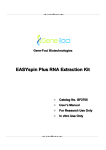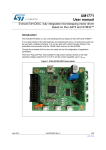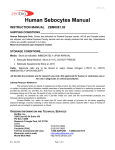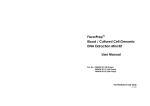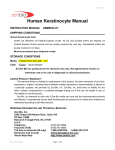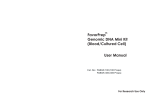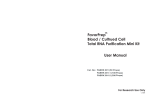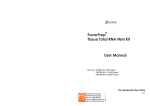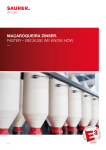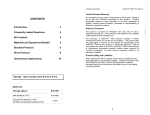Download User`s Manual - Gene-Foci
Transcript
Gene-Foci Biotechnologies EASYspin RNA Extraction Kit ◆ 270 4 Catalog No. GF GF270 2704 ◆ User User’’s Manual ◆ For Research Use Only ◆ In vitro Use Only EASYspin RNA Extraction Kit GF 270 4 Catalog No. No.:GF GF270 2704 Catalog No. Preps GF 270 4-50 GF270 2704 50 270 4-200 GF GF270 2704 200 � APPLICATIONS Ideal for fast RNA extraction from cells and tissue samples. � Kit Contents And Storage Conditions PCR Purification Kit Storage Conditions 50 preps 0 preps 20 200 Lysis Buffer RLT Room Temp. 50 ml 20 0 ml 200 Buffer RW1 Room Temp. 40 ml 160 ml Wash Buffer RW Room Temp. 10 ml 40 ml Add ethanol before first use RNase-free H2O Room Temp. 10 ml 40 ml 9 ml RNase-free H2O 36 ml RNase-free H2O 70% Ethanol Room Temp. Add ethanol before first use RNase-free Columns RA Room Temp. 50 0 20 200 and Collection Tubes This kit can be stored at room temperature for up to 12 months without showing any decrease in quality and yield. -1- � NOTES 1. All buffers should be clear. Lower temperature may cause precipitation. If any precipitation forms, warm at 37C water bath to dissolve before use. 2. The Easyspin RNA Extraction kit should be stored at room temperature, store at 4°C or -20°C may cause chemical compound precipitation in buffers. 3. Recap the bottles immediately after use to avoid unexpected oxidation, evaporation and change of pH due to long term exposure to the air. � INTRODUCTION The Easyspin RNA Extraction Kit offers a fast and easy way to extract high quality RNA from tissues and cells. The whole precess is phenol/chloroform-free. The unique lysis buffer immediately lyses biological samples and inactivates RNase and DNase. Ethanol is added to the lysate to provide appropriate binding conditions for RNA, and RNA selectively binds to the silica-membrane of the RNA column in the high-salt buffer. RNA is purified through a series of wash-spin steps to remove protein followed by elution of RNA from silica membrane with RNase-free H2O. � HIGHLIGHTS 1. High quality silica membranes are used to ensure the yield and consistency between different batches. 2. Fast, and convenient. The whole RNA purification process from one sample can be done within 30 min . 3. Multiple washing steps guarantee high-quality RNA purification. The OD260/280 of -2- the RNA product is typically between 1.8-2.1. � ATTENTION 1. All the steps should be performed at room temperature, use microcentrifuge such as Eppendorf 5415C or similar model that can handle 13,000 rpm or higher speed. 2. Materials and reagents to be supplied by the user: ethanol, 2-mercaptoethanol, single use syringes, mortar and pestle. 3. Lysis buffer RLT and wash buffer RW1 contain irritating chemicals, wear gloves when handling. Avoid direct contact with skin, eyes and clothes. If contaminated, rinse with large amount of water immediately. 4. To prevent RNase contamination, the following precautions should be taken when handling RNA: 1). Change gloves frequently to avoid RNase contamination from the skin. 2). Use RNase-free plasticware and tips to avoid cross-contamination. 3). RNA will not be degraded in Buffer RLT Plus. But in the subsequent steps, RNase-free plasticware and glassware should be used. Glassware should be oven baked at 150°C for 4 hr. Plasticware can be treated with 0.5 M NaOH for 10 min, followed by thorough rinse with water and autoclave. 4). Use RNase-free, DEPC-treated water to prepare solutions (add DEPC to water at a final concentration of 0.1% (v/v), and leave at 37°C overnight and autoclave). 5. RNA detection: Integrity of RNA: The integrity of the purified RNA can be detected by agarose gel electrophoresis (1.2% agarose gel; 0.5x TBE buffer). The ribosomal RNA (rRNA) should appear as sharp bands on the ethidium bromide-stained gel -3- under UV. 28S rRNA bands should be present with the intensity approximately twice that of the 18S rRNA band. If the rRNA bands appear as a smear of smaller sized RNAs, it is likely that the RNA sample is degraded during preparation. Purity of RNA: The ratio of OD260/OD 280 provides an estimate of the purity of RNA with respect protein contamination. However, the OD260/OD 280 ratio is influenced considerably by pH. Lower pH results in a lower OD260 /OD280 ratio and reduced sensitivity to protein contamination. In 10mM Tris, pH7.5, pure RNA has a OD260/OD 280 ratio of 1.8-2.1. In water, the ratio is 1.5-1.9, and this does not mean the RNA is not pure. Quantification of RNA: Dilute the RNA sample with RNase-free water, and measure the OD260 using a spectrophotometer which has been calibrated with RNase-free water. The concentration of RNA sample (ng/µl) is calculated using the following formula: OD260 x 40 x dilution factor. -4- � EASYSPIN RNA EXTRACTION KIT PROTOCOL ” part before start. Please read “Attention Attention” Hints Hints: � Before the first use, add the indicated amount of ethanol into buffer RW and 70% ethanol bottles, mix well, and mark the bottle with a check. � Before the first use, please add 2-mercaptoethanol to Buffer RLT to achieve a final concentration of 1% working solution. For example, add 10 µl of 2-mercaptoethanol per 1ml Buffer RLT. This mixture can be stored at 4C for one month. Procedure 1. Culture cells a. Harvest <107 cells grown in suspension into a centrifuge tube. Adherent cells can be lysed directly in cell-culture vessels or trypsinized from culture flasks b. and collected into a centrifuge tube. Centrifuge at 13,000xg for 10 sec (or 300xg for 5min) to pellet cells. Completely aspirate the supernatant. c. Note: Incomplete removal of the supernatant will decrease the yield and purity. Loosen the cell pellet thoroughly by flicking the tube. Add 350 µl (<5x106 cells) or 600 µl (5x10 6-1x107 cells) of Buffer RLT Plus, pipet or vortex to mix. d. e. 2. Homogenization: (cells <1x105 can be homogenized by vortexing for 1 min.) Pass the lysate at least 5 times through a 20-gauge needle (0.9 mm diameter) fitted to an RNase-free syringe. Homogenization shears genomic DNA, reduces the viscosity of the lysates, and increases the yields. Immediately proceed to Step 3. Animal soft tissues (for example, mouse liver and brain) a. Mince fresh tissues into small pieces, add 350 µl (<20 mg tissue) or 600 µl (20-30mg tissue) of Buffer RLT Plus. Homogenize with electronic tissue homogenizer for 20-40 s. Or b. Immediately place the tissue in liquid nitrogen, and grind thoroughly with a mortar and pestle. Transfer adequate amount (20mg/30mg) of tissue powder in to a 1.5 ml microcentrifuge tube containing 350 µl/600 µl of Buffer RLT , vortex for 20 s. Pass the lysate at least 5 times through a 20-gauge needle (0.9 mm diameter) fitted to an RNase-free syringe or homogenize with an electronic tissue homogenizer. This step shears genomic DNA, reduces the viscosity of the lysates, and increases the yields. -5- c. d. 3. Centrifuge the homogenized lysate at 13,000 rpm for 3 min. Transfer the supernatant into a new centrifuge tube. Immediately proceed to Step 3. Add equal volume of 70% ethanol (usually 350 µl/600 µl, adjust the ethanol volume accordingly if some lysate is lost during the above procedure) and pipet to mix immediately. Precipitation may be formed after the addition of ethanol, but this does not affect the procedure. Do not centrifuge. 4. Transfer up to 700 µl mixture into a RNA binding column (RA column) placed in a 2 ml collection tube (provided). Centrifuge at 13,000 rpm for 30 s, and discard the flow-through. Repeat this step if the sample volume exceeds 700 µl. 5. Add 700 µl Buffer RW1, and incubate at room temperature for 30s. Centrifuge at 12,000 rpm for 30s. Discard the flow-through. (Incubate for 5 min at room ation if obvious DNA remains). temperature before centrifug centrifugation 6. Add 500 µl Buffer RW, and centrifuge at 12,000 rpm for 30 s. Discard the flow-through. Repeat Step 6 with another 500 µ l Buffer RW. 7. Place the RA column back into the same collection tube. Centrifuge the empty RA column at 13,000 rpm for 2 min to completely remove ethanol from the column. 8. Place the RA column in a RNase free microcentrifuge tube. Add 30-50 µl of RNase free water (pre-warm the water to 70-90 70-90°° C will increase the RNA yield) to the center of the column membrane. Incubate at room temperature for 1 min, and centrifuge at 12,000 rpm for 1 min to elute the RNA. 9. If the expected RNA yield RNase-free water, or using is >30 μg, repeat step 8 with another 30 –50 μl 30– the eluate from step 8 (if high RNA concentration required). Reuse the centrifuge tube from step 8. of is The RNA yield should be 15–30% higher if using a second volume of RNase-free water than that obtained using the eluate from step 8, however, the final RNA concentration will be lower. -6- Ordering Information To order Gene-Foci products, please try the following methods: (1) Order online Register for an account on www.Gene-Foci.com, login, and place your order using our shopping cart and secure online checking out system. (2) Call our toll-free number +1-888-315-9018 (3) Send Email to [email protected] (4) Fax your order to +1-888-959-0868 To expedite your order, please provide the following information: Customer user name Purchaser’s name and detailed contact information Purchase Order Number (If any) Billing address Shipping address Description of the order -7-








